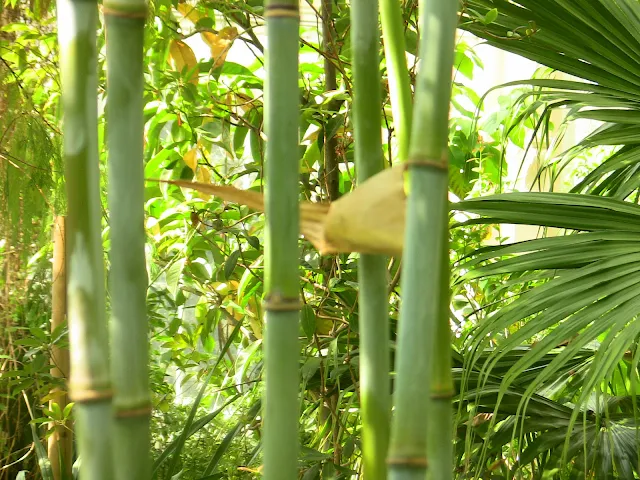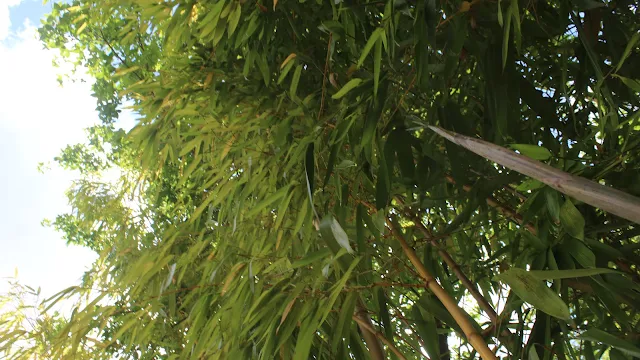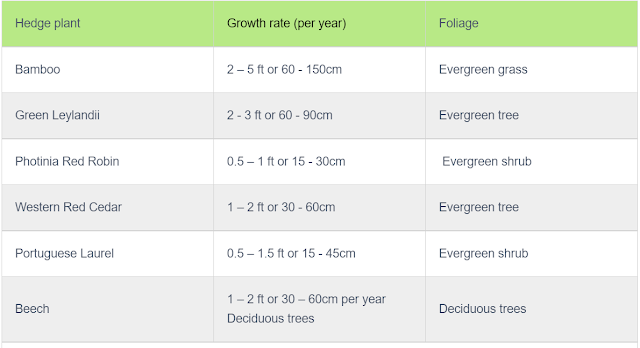Fargesia murielae nitida bamboo (commonly known as the Chinese Fountain Bamboo or Blue Fountain) is a fantastic plant for shade, part-shade and sun.
A Fargesia nitida grove has thick foliage that resembles mushrooms or ‘water fountains’ that is why they are called the fountain bamboo plants.
The stems often have different colours from red, pink, and purple to green.
A spectacular non-invasive bamboo plant, it will not send its shoots away from the parent plant. The clumps form a dense upright wall to support the ‘fountain’ foliage.
Fargesia murielae nitida is among the stunning Fargesias in the UK, owing their names to the appearances of the evergreen fountain-like foliage and coloured stems.
7 best Fargesia murielae nitida bamboo plants
A few years ago, only two clump-forming bamboo plants are known in the UK - the Fargesia nitida and mureilae varieties.
Today, successful pollination between the two clump-forming bamboos resulted in many hybrids of bamboo plants. Often those bamboos have different coloured stems and foliage.
As they say, for every garden, there is just the right bamboo for it!
In this section of the featured plants, we will take a look at the 7 Fargesia murielae nitida bamboo plants that are common in many UK homes and gardens.
You may find one that is right for you.
1. Fargesia nitida 'Black Pearl’ Fountain Bamboo
The Black Pearl bamboo is a spectacular Fargesia murielae nitida. It has purply black culms and overarching green foliage. It grows to 4m in full height and spread 2 - 3m across.
Black Pearl bamboo grows well in pots and containers and adds a great effect to patios, balconies and courtyards.
Although this clump-forming bamboo is undemanding, it will need good soil and water during and immediately after planting.
Soil preparation is key to giving it a good start.
Add mulch, fertiliser or organic compost to preserve moisture and preserve the soil nutrient content.
Best qualities of Black Pearl: A spectacular fountain bamboo with purply black culms and overarching green foliage, non-invasive. Grows well in shade.
2. Fargesia nitida 'Winter Joy’
Winter Joy is a hybrid plant known by its full name as Fargesia marielae nitida 'Winter Joy’.
It is a stunning new plant that has all the ‘goodies’ from the Fargesia nitida and marielae bamboo plants.
This clump-forming bamboo has upright culms with beautiful shades of green and grey. Its leaves are evergreen all year round. It can reach 3 – 4m in height and forms clusters 2 – 3m across.
Like most Fargesia marielae nitida, the Bamboo Winter Joy grows well in large pots and containers.
It is tolerant to changes in weather but prefers a shade to a part-shade area; and nutrient-rich soil with good drainage.
Best qualities of Winter Joy: A beautiful purple sheath and greyish-purply pink tall and upright stems, evergreen dense foliage and non-invasive.
3. Fargesia nitida 'viking’ Fountain Bamboo
Fargesia nitida 'Viking’ is a hybrid (a cross between Fargesia nitida and murielae).
This elegant hybrid clump-forming bamboo is non-invasive, it does not need a barrier because of its tight clump-forming nature.
Perfect for small gardens and pots or containers or grown as a single plant. It prefers partially shaded sites with higher humidity.
Like other Fargesia bamboos, the bamboo 'Viking' will thrive in nutrient-rich soil and where there is good moisture.
Best qualities of Fargesia nitida 'viking’: The long evergreen foliage and edges can be pruned to give a compacted evergreen hedge, stunning purple to green stems and non-invasive.
4. Fargesia nitida 'Volcano’
Fargesia nitida ‘Volcano’ is a stunning, non-invasive bamboo.
It has a beautiful reddish black stem and brown sheath which forms a beautiful contrast between the dense green leaves.
The Volcano can grow to a height of 2 metres, its clumped base can reach 1.5 to 3 metres wide. A good choice for pots and containers or can be planted directly into the ground as a screen or hedge.
This clump-forming bamboo is non-invasive and prefers moist soil and full sun or partial shade. Avoid growing the Volcano Bamboo in waterlogged sites and strong winds.
Best qualities of Fargesia nitida 'Volcano’: The foliage and edges can be pruned to give a compacted evergreen hedge, beautiful red black stems and non-invasive.
5. Fargesia nitida ‘Pillar’
Fargesia nitida ‘Pillar’ has beautiful slender evergreen foliage. It has tight upright stems that go from green to deep dark purple when matured and arched at the tops.
This clump-forming fountain bamboo can grow 3 metres high and is extremely hardy at temperatures below –20 degrees Celsius.
The Nitida Pillar bamboo is highly tolerant of shady making it the best plant for container cultivation and small gardens.
It does not like compacted building soil or very dry sites. It can be used for screening but prefers large pots, containers and shades.
In the dry season, water well or apply mulch and organic composts.
Top Qualities of Fargesia nitida ‘Pillar’: Deep dark green leaves and tall slender clums, prefers shade, ideal for large pots and containers.
6. Fargesia nitida 'Jiuzhaigou’ Bamboo
Fargesia Nitida 'Jiuzhaigou' Red Panda Fargesia Bamboo has colourful stems with evergreen leaves.
The stems/culms emerge green, turn deep red and mature to yellowish orange. A spectacular change in colours is a response to the amount of light the stems receive and how well they’ve matured.
Unlike the other Fargesia in this article, 'Jiuzhaigou' required a lot of direct sunlight.
The clump-forming bamboo thrives in moist well-drained soils. When planted in large pots and containers, the soil must be kept moist and nutrient-rich to make it happy.
Fargesia nitida 'Jiuzhaigou’ is a hardy bamboo, it grows to an average height of 3 metres and spread 2 metres in clump formation.
Best qualities of Fargesia nitida 'Jiuzhaigou’: Spectacular change in the colour of the culms/stems from emerging green to deep red and aged yellowish orange. Needs sunlight for best result.
7. Fargesia nitida 'Obelisk’
Fargesia ‘Obelisk’ is a hybrid bamboo with evergreen leaves contrasting with the dark tall culms, it has the best of the qualities from the parent bamboos, the Murielae and Nitida.
This beautiful bamboo is known to produce numerous shoots and leaves every year.
Obelisk Bamboo is ideal as a standalone bamboo and makes a great ornamental garden centrepiece. It can also be grown in pots and containers, or as privacy screens and hedges to great effect.
This clump-forming bamboo is hardy and can withstand temperatures to a low -25 degrees Celsius.
Bamboo Obelisk culms can grow to 4m tall and support their dense green foliage. This bamboo thrives in part shade and shade.
Best qualities of Fargesia nitida 'Obelisk’: Great standalone plant, it produces masses of new shoots and leaves yearly. The clump-forming bamboo had dense green foliage and thin hardy culms. It is non-invasive.
Clump-forming Fargesia bamboo plants for sale
Here is where to buy the clump-forming bamboo plants online.
We listed some top UK Home and Garden bamboo suppliers like Crocus and YouGarden.
Also, check out Amazon bamboo suppliers.
Summary of features of Fargesia murielae nitida
This group of clump-forming bamboo plants is best for a garden centrepiece but can also be ideal for hedging and privacy screening when grown in rows.
They are also fantastic shade plants, yet grow well in contained spaces, large pots and containers.
It can grow to 4m in height and spread 2 – 3m across.
- Site: Partial shade, or shade.
- Soil: Moist but well-drained fertile soil.
- Uses: Pots, containers, or individual planting.
- Winterhardiness: - 24 degrees Celcius
- Height: 3 – 4m
- Spread: 1.5 - 2m
- Foliage: Overarching green foliage, coloured stems.
- Grow & care: Clump-forming bamboo, non-invasive and undemanding.
7 Best Fargesia Murielae Nitida Bamboo Plants to grow for a thick screen, hedge and in garden.



![Fargesia nitida Obelisk [Fargesia murielae and Fargesia nitida Hybrid] Fargesia nitida Obelisk UK](https://i0.wp.com/www.gardenbambooplants.com/wp-content/uploads/2021/09/fargesia-nitida-obelisk1.jpg?w=800&ssl=1)







